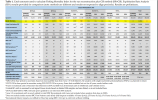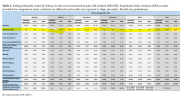Big Bar landslide response information bulletin
November 1 2021
On this page
2021 monitoring program wraps up at Big Bar
With the tail end of the coho migration now passing through the upper Fraser River, the majority of the 2021 fish monitoring field work has successfully concluded.
Radio tagging led by First Nations and DFO ended on October 15. In total, 363 Chinook, 601 sockeye, 212 pink and 156 coho were tagged at the Lillooet fish wheel. The sonar equipment installed near the Big Bar ferry (Alfalfa) and at Churn Creek were removed on October 19. At the same time, telemetry monitoring in the upper Fraser watershed by the Upper Fraser Fisheries Conservation Alliance (UFFCA) will continue until the end of the migration period in November.
The monitoring team now begins its in-depth analysis of the large volumes of data collected from the radio telemetry and sonar programs. The group will process, interpret and compile the results to accurately measure species migration, delay, spawning success and distribution. The final data will provide a detailed evaluation of the passage conditions for the stocks that move through the Big Bar area.
First Nations partnerships support Big Bar enhancement program
In collaboration with DFO’s Salmonid Enhancement Program (SEP), First Nations and other community partners are supporting the Big Bar enhancement program this season by incubating and rearing salmon fry. The milt and eggs were collected from brood stock captured at the Lillooet fish wheel and through the natal stream program. This work will contribute to the conservation and rebuilding of critical salmon stocks, and help refine future Big Bar enhancement plans.
Hatchery programs are challenging as facility operations require careful planning, specifications, and the installation and testing of many critical components. A key part of the process is the constant monitoring and maintenance, including the quality of the water supply, waste management and discharge, and alarm systems.
DFO continues to work closely on enhancement planning and operations with the First Nations that were affected by the slide across the mid- and upper Fraser region.
Enhancement planning underway for 2022 Fraser salmon migration season
In addition to implementing the 2021 enhancement activities, the Big Bar response team has started planning for the 2022 program. Three technical groups have been reengaged. In addition to developing the 2022 enhancement plan, they will focus on designing release strategies for the 2021 Chinook and sockeye fry, manage fish health and organize crews.
Each group consists of Indigenous fisheries experts from Takla First Nation, Nak'azdli Whut'en, the Tsilhqot'in National Government, Carrier Sekani Tribal Council, and the UFFCA, as well as DFO staff from SEP, and the Stock Assessment and Resource Management branches. Participants are playing a key role in the conservation and recovery of impacted salmon populations.
The enhancement program remains a critical component of the landslide response as the team pursues a long-term solution for fish passage at Big Bar.
Current images of work being done at the landslide site

Late Stuart sockeye eggs were fertilized with milt (left) and are being held in incubation trays (right) at the Nak'azdli Whut'en hatchery Click to enlarge.
Additional images of the work underway as part of our response efforts can be seen on the
Government of BC’s Flickr channel.


